BOSTON, Jan. 30 /PRNewswire/ -- Neurosilicon's novel Photoconductive Stimulation Device (PSD) was highlighted in the recent scientific publication by Hung and Colicos titled, Astrocytic Ca2+ Waves Guide CNS Growth Cones to Remote Regions of Neuronal Activity. The article appearing in the November 2008 issue of The Public Library of Science One journal focuses on the role of neuronal activity in mediating axonal guidance. It is known that the path axons follow is important in defining neuronal connectivity in the brain. Following an injury, axons must find their way back to their proper targets or find new ones in order to achieve functional recovery. Given this, researchers have sought to better understand how axon guidance is mediated in order to potentially aid in recovery following injury.
Focusing on the affects of action potential induced depolarization, Hung and Colicos sought to extend previous findings and investigate how axonal growth cones respond to actual physiological stimulation in spatially displaced neurons. To do this' they applied photoconductive stimulation technology. One of the strengths of photoconductive stimulation is that it is optically activated and therefore non-invasive, requiring no physical cellular perturbation to elicit depolarization. Additionally, photoconductive stimulation has greater spatial specificity than extracellular field stimulation as well as greater temporal resolution than direct neurotransmitter application. Previously, photoconductive stimulation has been applied to demonstrate activity-driven new synapse formation in cultured neurons while allowing for the dynamic observation of the cellular elements within the neurons. In the current study, the application of photoconductive stimulation induced high frequency action potentials revealing that activity serves as an attractant signal for growth cones. These observations suggest a signaling pathway for activity-dependant axon guidance in which growth guidance both spatial and temporal is mediated by neuronal activity. Further under experimental conditions simulating injury, it was observed that growth cone attraction was not inhibited suggesting that this mechanism could be used to guide neuronal regeneration following axonal injury.
Photoconductive stimulation has enabled researchers to significantly expand the depth, breadth, and complexity of approaches aimed at understanding and addressing areas of unmet neurological healthcare need. This novel technology provides researchers with the means to dynamically study excitation dependent cellular responses without the requirement for a direct physical link to the cell (such as with electrodes in patch clamping or transistor contact necessary in micro electrode arrays). The PSD can also be used in place of pharmacological agonist stimulation, which does not allow for specific cell targeting and/or rapid repetitive depolarization.
About Neurosilicon
Neurosilicon develops novel brain-computing interfaces to expand the scientific understanding of the human brain and to revolutionize and improve the effectiveness of drug discovery. The company's flagship product, the Photoconductive Stimulation Device (PSD) stimulates excitable cells in a precise and controllable fashion. Neurosilicon is comprised of a multidisciplinary team of neuroscientists and engineers working together to advance the boundaries of life science research.
For more information on the (PSD), or to order, please visit http://www.neurosilicon.com
CONTACT: Steven Munevar, Ph.D., MBA, Neurosilicon, +1-508-450-5465,
steven@neurosilicon.com
Web site: http://www.neurosilicon.com//




